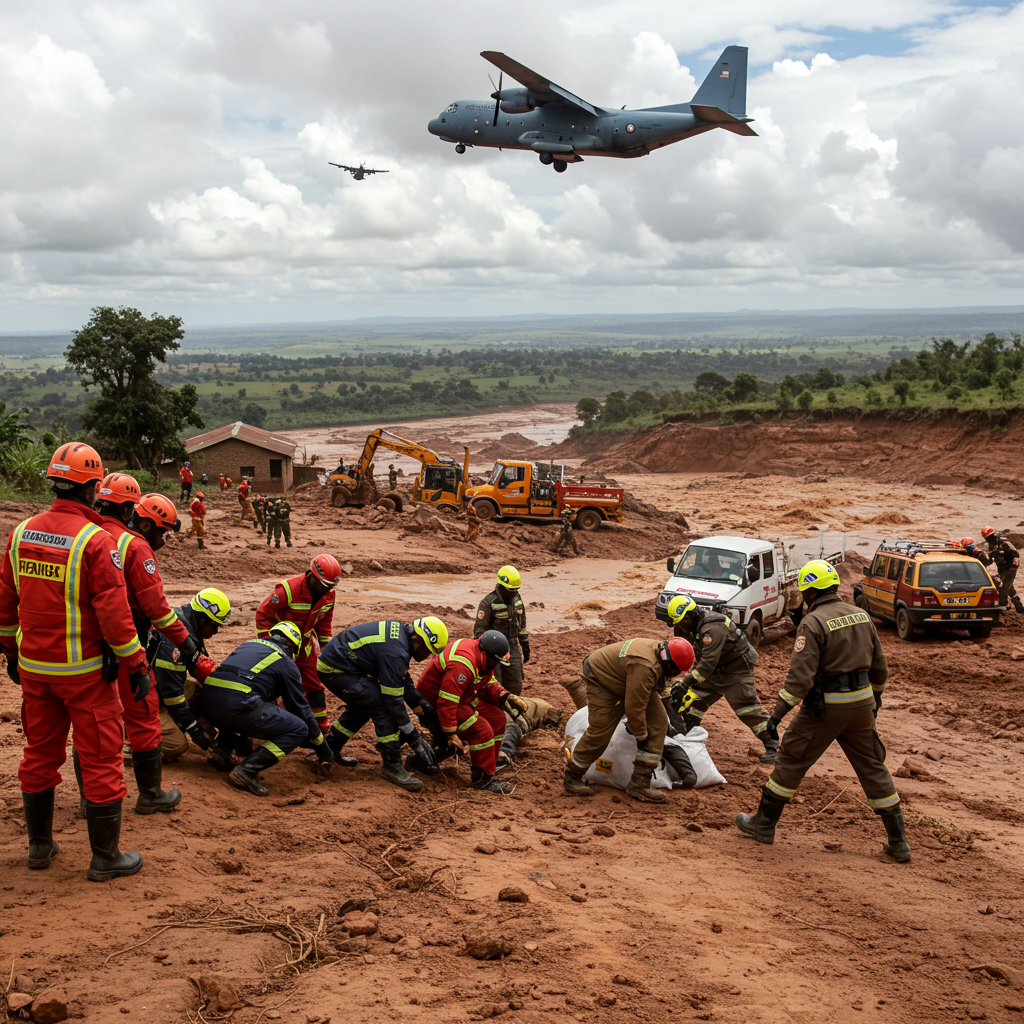A devastating landslide in Kenya’s Rift Valley has claimed at least 26 lives, with flash floods now severely impeding crucial rescue operations. This unfolding humanitarian crisis in western Kenya highlights the perilous intersection of extreme weather and vulnerable communities. As emergency teams grapple with treacherous conditions, the government is intensifying efforts, deploying military aircraft to reach cut-off areas and deliver vital aid. The tragedy underscores a broader pattern of heavy rainfall impacting thousands across the nation, prompting urgent calls for evacuation in high-risk zones.
The Tragedy Unfolds in Chesongoch
The deadly incident occurred on Saturday in the Chesongoch area of Elgeyo Marakwet county, nestled within Kenya’s geologically active Rift Valley region. Heavy, incessant rains triggered a catastrophic landslide, which tore through communities, sweeping away homes and vital infrastructure. Roads leading into the affected zone were obliterated, completely severing access and leaving residents stranded. The sudden and powerful torrent of mud and debris left little time for escape, catching many families unprepared as the ground beneath them gave way.
Mounting Casualties and Desperate Search Efforts
By Sunday, the grim death toll from the Chesongoch landslide had tragically climbed to 26, with four more bodies retrieved amidst the wreckage. Interior Minister Kipchumba Murkomen confirmed that a staggering 25 individuals remain unaccounted for, fueling fears that the final casualty count could rise further. In response, the Kenyan government escalated its search and rescue mission, dispatching four military aircraft to help teams access the isolated area. These aerial assets are critical for transporting personnel and equipment to locations that are otherwise unreachable, navigating the vast and challenging terrain of the Rift Valley.
Flash Floods: A Relentless Obstacle to Rescue
The desperate search for survivors, however, faced an overwhelming new challenge on Sunday: severe flash floods. As rescue teams toiled on the ground, fresh deluges of water and mud cascaded from a nearby hill in Chesongoch, forcing an immediate and heartbreaking suspension of operations. These sudden floods not only endangered the search personnel but also re-covered areas that had previously been cleared, adding layers of complexity to an already perilous situation. Oscar Okum, the regional manager for the Kenya Red Cross, emphasized the persistent danger, noting that even “roads that are already opened [are] being populated again by mudslides.” He stressed that the area remains an “active incidence,” underscoring the dynamic and unpredictable nature of the disaster.
Kenya’s Broader Flood Crisis and Climate Vulnerability
The Chesongoch landslide is not an isolated event but part of a wider, escalating crisis gripping Kenya. Heavy rainfall has persisted across the nation, leading to widespread flooding in multiple counties and displacing thousands of people. Meteorologists warn that these torrential rains are expected to continue, exacerbating already precarious conditions and increasing the risk of further landslides and floods. This pattern aligns with broader climate change trends, where East Africa has experienced more frequent and intense weather phenomena, including both prolonged droughts and devastating floods. Understanding Kenya’s inherent vulnerability to such events, particularly in regions like the Rift Valley, is crucial for long-term disaster preparedness.
Government Mobilization and Humanitarian Response
In the face of this deepening crisis, the Kenyan government has pledged a comprehensive response. Interior Minister Murkomen detailed extensive efforts aimed at supporting affected communities.
These initiatives include:
Airlifting Supplies: Essential aid is being airlifted to cut-off areas, including 15 schools that have been isolated by the floods.
Ensuring Education Continuity: Crucially, ongoing national examination papers are also being airlifted to candidates in these remote locations, striving to maintain educational normalcy amidst the chaos.
Medical and Resettlement Support: The government has committed to covering the medical expenses for over 30 injured individuals and facilitating the resettlement of dozens of families whose homes were destroyed.
Murkomen expressed profound sorrow over the scale of the human tragedy, lamenting that some families have tragically lost “five to six immediate family members.” This human element underscores the deep trauma and loss permeating the affected communities, requiring not just material aid but also psychological support.
Understanding the Rift Valley’s Geological Vulnerability
The Rift Valley region, while breathtakingly beautiful, is inherently susceptible to geological instabilities like landslides. This vulnerability stems from several interconnected factors:
Geological Formation: The Great Rift Valley is a tectonically active zone, characterized by steep escarpments, fault lines, and varied soil compositions. These geological features make its slopes naturally prone to collapse under certain conditions.
Soil Types: Many areas feature loose, volcanic soils or deep layers of weathered rock. When these soils become saturated with heavy rainfall, they lose their cohesion and turn into a heavy, flowing mass.
Deforestation and Land Use: Human activities, such as deforestation for agriculture or settlement, can exacerbate natural vulnerabilities. Removing vegetation cover diminishes the soil’s stability, making it more susceptible to erosion and landslides during heavy downpours.
Intense Rainfall: The sheer volume and intensity of recent rains have overwhelmed the soil’s capacity to absorb water, triggering events in areas that might otherwise have remained stable.
These factors combine to create a landscape where natural disasters are not just possible, but, sadly, often predictable when extreme weather strikes.
Long-Term Impact on Displaced Communities
The impact of the Chesongoch landslide and the broader flood crisis extends far beyond the immediate casualties. Thousands of people have been displaced, losing not only their homes but also their livelihoods, often tied to agriculture in these fertile regions. The psychological toll on survivors and affected families is immense, marked by trauma, grief, and uncertainty about the future. Children face disrupted schooling, while communities face the daunting task of rebuilding from scratch, often without adequate resources. This calls for sustained, long-term humanitarian aid that addresses not just immediate needs but also the complex process of recovery and rehabilitation.
Building Resilience: Strategies for a Safer Future
To mitigate the devastating effects of such disasters in the future, a multi-faceted approach focusing on resilience and preparedness is essential. Key strategies include:
Early Warning Systems: Implementing robust meteorological monitoring and community-based early warning systems can provide crucial time for evacuations.
Sustainable Land Management: Promoting reforestation, terracing, and other land-use practices that stabilize slopes and reduce soil erosion.
Infrastructure Resilience: Investing in infrastructure that can withstand extreme weather, such as improved drainage systems and stronger road networks.
Community Education: Educating residents in high-risk areas about the dangers of landslides and floods, and how to respond during an emergency.
Relocation Planning: Identifying and supporting the safe relocation of communities from the most vulnerable areas to more secure grounds, as urged by the government.
These measures, coupled with responsive government and humanitarian efforts, are vital for protecting lives and livelihoods in a region increasingly exposed to the impacts of climate change.
Frequently Asked Questions
What caused the recent deadly landslide in Kenya’s Rift Valley region?
The recent deadly landslide in Kenya’s Chesongoch area was primarily triggered by torrential and sustained heavy rains. These rains saturated the region’s inherently unstable soils, particularly in the geologically active Rift Valley, causing the ground to lose cohesion and collapse. Factors like the steep slopes, specific soil types, and potentially historical land use practices also contribute to the area’s vulnerability to such events during periods of extreme rainfall.
How is the Kenyan government responding to the disaster and supporting affected communities?
The Kenyan government, through Interior Minister Kipchumba Murkomen, has initiated a comprehensive response. This includes deploying four military aircraft to aid in search and rescue operations and to access cut-off areas. They are airlifting essential supplies, including national examination papers for students, to 15 isolated schools. Furthermore, the government has pledged to cover medical expenses for over 30 injured individuals and plans to resettle dozens of families whose homes were destroyed by the landslide.
What are the immediate safety recommendations for residents in flood and landslide-prone areas of Kenya?
The government and organizations like the Kenya Red Cross have issued urgent safety recommendations. Residents in flood and landslide-prone areas are strongly advised to evacuate immediately and move to safer, higher grounds. This is crucial as heavy rains are expected to continue, and the Red Cross has warned that new mudslides can occur even on previously cleared roads. Heeding these warnings and seeking safe shelter is paramount for protecting lives and livelihoods.
Conclusion: A Call for Unity and Preparedness
The devastating landslide in Kenya’s Rift Valley serves as a stark reminder of nature’s formidable power and the increasing vulnerability of communities to extreme weather events. With 26 lives lost and scores still missing, the immediate focus remains on rescue and recovery, an effort severely hampered by ongoing flash floods. The resilience of the Kenyan people, coupled with the determined efforts of the government and humanitarian organizations, is crucial in navigating this profound crisis. Beyond the immediate response, this tragedy underscores the urgent need for enhanced disaster preparedness, sustainable land management, and continued global support to help vulnerable regions build a more resilient future against the unpredictable forces of a changing climate.



